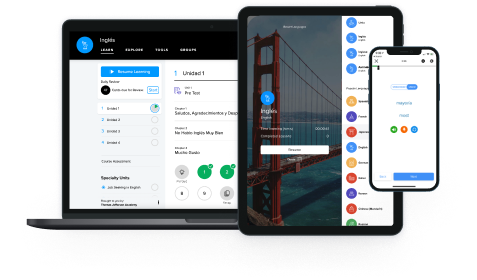You see a sus hijos in both examples. Please don’t get confused by the use of “a”: in the first case, it is used because it precedes a direct object that is a person (this is a rule in Spanish) but in the second example it precedes an indirect object. The translations help to clear things up: when “a” precedes a direct object, it is not translated into English; when placed before an indirect object, it is usually translated as “to.”

How to use direct and indirect object pronouns in Spanish?
Direct and indirect are used to replace the or of a sentence. While in English direct and indirect pronouns are used after the (I ate it), in Spanish they are usually placed before the conjugated verb (Lo comí). However, this is not always the case, especially when these pronouns are with other forms of verbs. In these cases, the object pronoun is placed after the verbal form (comerlo). Let’s see what direct and indirect objects are, which pronouns can be used for these functions, and finally how they are placed!
What is a direct/indirect object?
A direct object is the noun or noun phrase that is directly acted upon by the verb, and the indirect object is the recipient or goal of that action. Let’s take a look at these examples:
Ana describe un cuadro.
Ana describes a picture.
Ana describe a sus hijos.
Ana describes her children.
In the examples above, un cuadro and (a) sus hijos are the answers to the questions “what?” and “who(m),” respectively. (What does Ana describe? / Who(m) does Ana describe?). They are called “direct objects.”
Let’s take a look at this example now:
Ana describe un cuadro a sus hijos.
Ana describes a picture to her children.
In this example, we see a new element, a sus hijos(to her children) (to her children). This element answers the question, “to who(m)?” and is called an “indirect object.” In fact, indirect objects answer the questions, “to who(m)” or “for who(m).”
Did you know?
Which are the direct and indirect object pronouns?
Together, the and are me, te, nos, os, lo, la, los, las, le, and les. These pronouns are used to replace direct and indirect objects. For example:
Ana describe el cuadro. → Ana lo describe.
Ana describes the picture. → Ana describes it.
For the direct and indirect object pronouns that correspond to yo(I), tú / vos(you – informal), nosotros / nosotras(we), vosotros / vosotras(you all) — which, by the way, is only used in Spain — you don’t need to get a headache remembering these grammar terms, because you just use the same pronoun for the direct and the indirect object:
Pronoun Type | yo(I) | tú, vos(you) | nosotros, nosotras(we) | vosotros, vosotras(you all) |
|---|---|---|---|---|
Direct object | me | te | nos | os |
Indirect object | me | te | nos | os |
English object pronouns | me | you | us | you all |
Nos invitó a su fiesta de cumpleaños.
He invited us to his birthday party.
Me regaló un libro.
He gave a book to me.
On the other hand, for the pronouns that correspond to él(he), ella(she), ellos(they – masculine), ellas(they – feminine) (either person or object), or to usted, ustedes(you – singular, formal / you all – formal) you use different words:
Pronoun Type | él(he) | ella(she) | usted(you) | ellos(they) | ellas(they) | ustedes(you all) |
|---|---|---|---|---|---|---|
Direct object | lo | la | lo/la | los | las | los/las |
Indirect object | le | les | ||||
English object pronouns | him / her / it | you | them | you all | ||
Be careful! Direct object pronouns must agree in and with the they are replacing. In the following example, el pastel is the direct object of the sentence and it is a masculine singular noun, that is why the pronoun we need to use is lo.
¿Cocinaste el pastel? → Si, lo cociné.
Did you cook the cake? → Yes, I cooked it.
Now, let’s look at the example below: the noun las cartas is the direct object in this sentence, this noun is feminine plural, thus, we should use the pronoun las.
¿Enviaste las cartas? → Si, las envié.
Did you send the letters? → Yes, I sent them.
Need a refresher on how to tell the gender of Spanish nouns? How about, how to form the plural in Spanish? Look no further, we have posts for that!
Indirect object pronouns, on the other hand, only agree in number with the nouns they refer to since there are only two forms and no distinction between masculine and feminine. In the examples below, we use the indirect object pronoun to replace “your mother” and “your father” and as you can see, we use the pronoun le in both cases.
¿Compraste el regalo a tu madre? → Si, le compré el regalo.
Did you buy the present for your mother? → Yes, I bought the present for her.
¿Diste el regalo a tu padre? → Si, le di el regalo.
Did you give the present to your father? → Yes, I gave the present to him.
Now, let’s see how to place these pronouns in sentences.
Where do you place direct and indirect object pronouns in a sentence?
Direct and indirect object pronouns are always placed before the conjugated verb in simple tenses – except the positive imperative – and perfect tenses (those with haber + past participle):
¿Has cocinado el pastel? → No lo he cocinado todavía.
Did you bake the cake? → I haven't baked it yet.
Juan me escribió una carta.
Juan wrote a letter to me.
What happens when both the direct object pronoun and the indirect object pronoun are used in the same sentence? The indirect object pronoun always goes before the direct object pronoun. Take a look at the examples below:
Te la envié.
I sent it to you.
Me los dieron.
They gave them to me.
What is ‘se’?
Se is another form of an indirect object pronoun. When the indirect object pronouns le and les are combined with the direct object pronoun lo, la, los, las, the indirect object pronouns change to se:
¿Compraste el libro a María?
Did you buy the book for María?
Se (le) lo compré.
I bought it for her.
Or in another example:
¿Compraste el libro a los estudiantes?
Did you buy the book for the students?
Se (les) lo compré.
I bought it for them.
As you can see, le and les become se. Thus, in the examples above, se refers to both María (feminine singular) and los estudiantes (masculine plural). Check out this strategy to remember this rule!
Pronouns with imperatives, infinitives, and gerunds
With positive , , and , the direct and indirect object pronouns are placed after the verb. They attach to the verb, forming one single word:
Pronoun Type | Positive Imperative | Infinitive | Gerund |
|---|---|---|---|
Direct object | ¡Come! Eat! ¡Cómelo! Eat it! | comer to eat comerlo to eat it | comiendo eating comiéndolo eating it |
Indirect object | ¡Escribe! Write! ¡Escríbeme! Write to me! | escribir to write escribirme to write to me | escribiendo writing escribiéndome writing to me |
What happens if we combine the direct and indirect object pronouns with these verb forms? As above, we maintain the same order: indirect object + direct object (and the se instead of le/les rule is also maintained):
Pronoun Type | Positive Imperative | Infinitive | Gerund |
|---|---|---|---|
compra | comprar | comprando | |
Direct object | cómpralo | comprarlo | comprándolo |
Indirect object | cómprale | comprarle | comprándole |
Indirect object + Direct object | cómpraselocómpramelo | comprarselocomprarmelo | comprándoselocomprándomelo |
As you may have observed, some verb forms have an accent mark when combined with these pronouns.
Pronouns with verb combinations
At times, object pronouns will be used alongside verb combinations. Verb combinations combine a conjugated verb and a non-conjugated verb. Some examples of verb combinations in Spanish are:
Ir a + infinitive (going to):
voy a comer
I am going to eat
Tener que + infinitive (have to):
tengo que trabajar
I have to work
Estar + gerund (to be + -ing verb):
estoy cantando
I am singing
When these forms are used with a direct/indirect object pronoun, we have two options:
We can put the pronoun(s) before the conjugated verb:
indirect object pronoundirect object pronounTe lo voy a cocinar.
I am going to bake it for you.
Se lo tengo que enviar.
I have to send this to her/him/you.
Se lo estoy llevando.
I am taking it to you.
Or, we can attach it to the non-conjugated verbs:
indirect object pronoundirect object pronounVoy a cocinártelo.
I am going to bake it for you.
Tengo que enviárselo.
I have to send this to her/him/you.
Estoy llevándoselo.
I am taking it to you.
Recall that we always maintain the same order: Indirect pronoun + direct pronoun. And do not forget se!
Summary
To sum up what we’ve seen, in Spanish we always place the indirect object pronoun before the direct object pronoun. In addition, both are always placed before the conjugated verb. Although with positive imperatives, infinitives, and gerunds, pronouns are attached to the word, creating one single word. We also saw that with some verb combinations, we can either place the pronouns before the conjugated verb or attach them to the non-conjugated verb of the verb combination. Also, remember that when le or les and a 3rd person direct object pronoun appear together, le(s) change to se. See the examples below for a brief summary of all the cases we mentioned in this post!
Placement with simple and perfect tenses:
direct object¿Compraste el libro?
Did you buy the book?
Sí, lo compré.
Yes, I bought it.
indirect object¿Has escrito la carta a Juan?
Have you written the letter to Juan?
No le he escrito la carta todavía.
I haven’t written him the letter yet.
Order Indirect Object + Direct Object:
indirect object pronoundirect object pronoun¿Te enviaste la carta?
Did you send me the letter?
Sí, te la envié.
Yes, I sent it to you.
Se instead of le or les:
indirect object pronoundirect object pronoun¿Compraste el libro a María?
Did you buy the book for María?
Sí, se (
le) lo compré.Yes, I bought it for her.
Placement with positive commands, infinitives, and gerunds:
cómpraselo
comprarselo
comprándoselo
Placement with verb combinations:
indirect object pronoundirect object pronounTe lo voy a cocinar.
I am going to bake it for you.
Voy a cocinártelo.
I am going to bake it for you.
That’s it! If you want to practice while learning how to cook Tortilla de Patata (a very typical Spanish dish), take a look at these activities we created. Enjoy!
